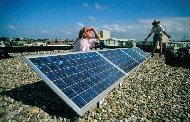|
|
                    
Solar
statistics Europe 2008
Zonne-statistieken
Europa 2008
On
this webpage several graphs I made from the data published by EurObserv'ER
in their ninth Report, "The State of Renewable Energies in Europe".
Op
deze pagina enkele grafieken die ik heb gemaakt van data gepubliceerd
door
EurObserv'ER in hun 9th Report, "The State of Renewable Energies
in Europe".
Market
development for photovoltaics in EU27 GRAPHS
Market development for thermal
solar collectors in EU27 GRAPHS
Concentrating Solar Power - summary (Dutch)
Progression
of renewable electricity in EU27 per country (Dutch)
GRAPH
Progression
of renewable energy in EU27 per country (Dutch) GRAPH
Links
More recent reports:
up till 2010, up
till 2009
Introductie
In februari
2010 werd een nieuw overzicht van statistieken over duurzame energie
in de EU27 gepubliceerd door EurObserv'ER. Polder PV selecteerde de
gegevens voor, met name, zonne-energie, maakte er enkele grafieken
van, en belichtte nog enkele opvallende zaken.
Grafieken met marktontwikkeling zonnestroom in EU27
Graphs with market development for photovoltaics in EU27
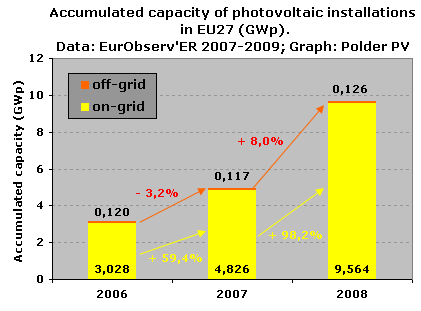
Figure
1. Accumulated capacity of photovoltaic installations in the EU27,
in GWp (1 GWp = 1.000 MWp = 1.000.000 kWp), in three consecutive
years (2006-2008) according to the latest data reported
by EurObserv'ER (note that numbers might be refreshed in new reports
dealing with previous years). Data for these and other graphs below come
from
the State of Renewable Energies in Europe report (publ. 2009) in which
the latest data for 2007 and 2008 were given. Numbers for 2006
come from the Photovoltaic Barometer report published April
2008.
The
graph shows strong growth in these years, and an absolute dominance
of grid-connected systems. Autonomous ("off-grid") systems
make up only 1,3% of the PV market and will dwindle further in significance.Growth
was even negative between 2006 and 2007 for this small category. Growth
in grid-connected PV was strong in that period (over 59%), and almost
doubled to 98 percent from the accumulated 2007 capacity into 2008, with
final accumulated capacity of 9,69 GWp (according to EurObserv'ER).
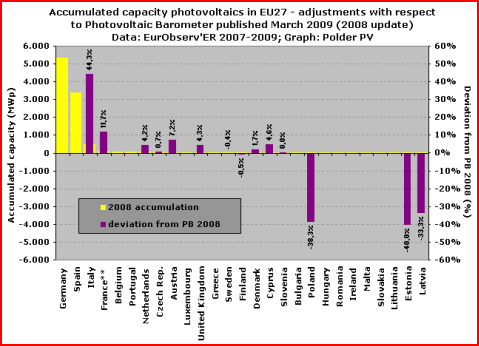
Figure
2. CLICK on graph to
see enlargement. EurObserv'er refreshed some older data in their
latest report. Here, the difference
is shown
for
the accumulation
data
for photovoltaic EU27 markets in 2008 between the latest Photovoltaic
Barometer (PB) report published March 2009, and the present State
of Renewable
Energies in Europe (SREE) report/edition 2009. The difference is shown
in percentage of the PB report findings in purple columns, data on the
right
Y-axis.
The original data from the SREE report are given in yellow columns, left
Y-axis. The adjustments are most striking for Italy with over 44% more
installations than previously reported (apparently a large backlog
of installed PV-capacity there), and to a lesser extent France with
almost 12% additions, most probably for a large part resulting from
including the
overseas departments (not included in the previous PB data). On the
"negative" side are adjustments to lower accumulations in the small
markets of Poland, Estonia and Latvia. Only a slight deviation from
predicted or preliminary accumulation records in such small markets
immediately leads to high percentages in the adjustment graph.
Note:
for the Netherlands only an estimation was done in the PB report
since apparently there were no actual data available at that time
from our authorities (Polder PV is located in the Netherlands). This
comes to no surprise, since keeping track of the mostly undocumented
(small) installations in our country is virtually impossible, and
reliable official publications for the actual growth of the now "subsidized"
market
segment (SDE: 2008 18 MWp "approved",
but at start of 2010 still only one third realized and accepted for
green certificates by CertiQ) are still lacking. In the SREE report
4,1 MWp has been
added instead
of the
previous
PB estimate
of
1 MWp for on-grid, and 0,6 MWp for off-grid installations. Note,
however, that the 2008 market report of the official CBS statistics
bureau, has stated a market
growth of 4,444 MWp for the Netherlands (4,205 MWp on-grid plus
0,239 MWp off-grid). Hence, another discrepancy between published
data.
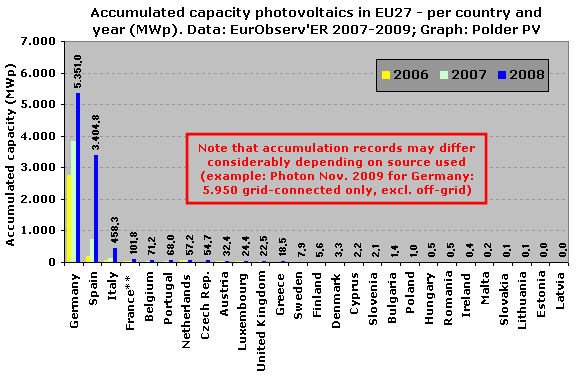
Figure
3. Accumulated PV-capacity per EU27 country (only for 2008 accumulation
is given in numbers). Note absolute dominance of world market Germany,
with over 5,3 GWp accumulated. Secondly, for the year 2008
a world
record increase
(difference between blue and green column, almost 2,7 GWp in one
year) for Spain, adding up to 3,4 GWp. The booming Spanish market,
however, collapsed because of a harsh 500 MWp/year cap introduced
by the Industry
Ministry for 2009.
Italy on
a good
third place with 458 MWp, with much potential (already
filled in the next year, 2009). The rest of the EU27 countries
is hardly visible on this scale (see graphs below). Actual accumulation
data
can differ considerably,
depending
on the source.
Therefore, mind the
red warning (also applicable to other graphs presented on this page):
the detailed numbers Photon obtained from the primary source for
reliable
PV data
in world
market
Germany,
the
almost 900
net managers, revealed that
in 2008 already 5,95 GWp were on the grid. 11% more
than the
EurObserv'ER data presented in this section, and not even accounting
for the off-grid installations that EurObserv'ER included in their
data (40 MWp).
Note
that for France**, the results for the overseas departments ("Departements
Outre Mer", DOM) also have been included in the accumulated
data. They account for
a respectable accumulated total of 30,5 MWp in 2008, representing
almost 30% (!) of the 102 MWp for the whole country.
This
should be kept in mind if one wants to consider the European
context
focussed
on
the old subcontinent and its neigbouring isles. The "DOM" isles,
French Guyana, and a small slice of Antarctica, all falling under
a variety
of administrative legislation frameworks, are scattered over the
globe and far removed from the direct "physical" influence sphere
of Europe, see English Wikipedia map
and accompanying clarifications.
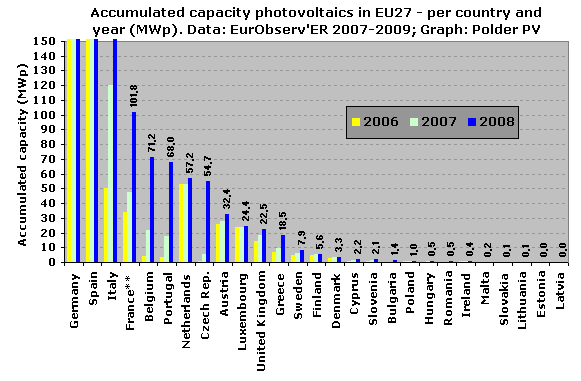
Figure
4. Same graph as figure 2, but with a scale better outlining the
data for the rest of the EU27 countries (Germany, Spain and Italy
running off the Y-axis). Note the strong differences in development
between the other countries: explosive growth in France, Belgium,
Portugal, and Czech Republic (good, uncapped incentive regimes).
But low
growth for my own country, the Netherlands. That once was on the
forefront
of
market
implementation,
but that
has
lost
all contact with reality with an extremely complicated, highly capped,
and hardly stimulating "incentive" regime as of April 1,
2008.
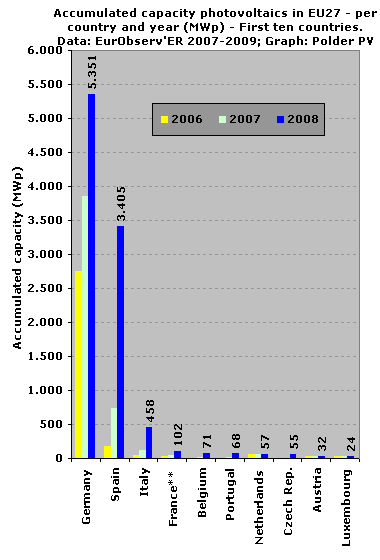
Figure
5. Detail showing the first 10 countries in the EU27, with huge variation
in the implemented PV-capacities. Difference between Germany and
the small country of Luxembourg already has grown to a factor 223
in 2008. Difference with Spain has shrunk dramatically from a factor
16
in 2006 to only 1,6 in 2008. However, due to market collapse in Spain
(2009), and explosive market
growth in Germany, the solar champion
renewed its absolute dominance with an estimated 3-4
GWp added only in that year (yet to be published by Bundesnetzagentur).
In the "top ten", the Netherlands, Austrian and Luxembourg
markets hardly grew significantly.
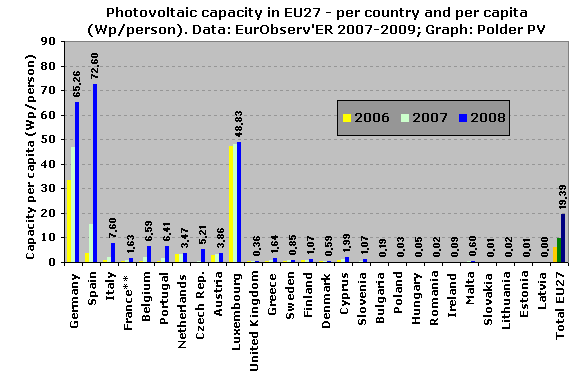
Figure
6. Accumulation of PV-capacity in EU27 countries per inhabitant/capita
and per year. For this, the World Population Reference Bureau data
for 2009 have been used in the calculations (hence: mid 2009 population
as fixed reference). A very different picture emerges, with the small
country Luxembourg as a suprising third on the podium. However: incentives
have been stopped
there, and growth as of 2006 has been very low. In contrast, the
ratios in other countries have been growing fast. Not only in the
world markets Germany and Spain, the latter temporarily taking the
lead in 2008 based on the present data. Also Italy, Belgium, and
the Czech Republic are developing fast. France has a relative low
impact in
this
graph but will probably grow faster in coming years (2009 included).
Cyprus is positioned relatively high with its rather small population
(1,1 million) but already
2,2 MWp of PV-installations (27% of which is off-grid according to
EurObserv'ER). In the right of the graph, the average data
for EU27 countries have been given in deviating colours. Already
over
19 Watt(peak)
per capita has been realized in the EU27 in 2008.
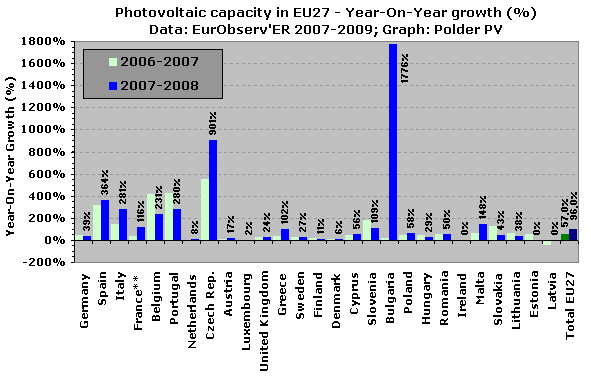
Figure
7. Year-on-year growth of the photovoltaic markets in EU27 countries
for 2007 and 2008, in percentage of the previous market
accumulation year published by EurObserv'ER. Actual percentages only
presented for
the period
2007-2008 for all countries.
Yet another
picture emerging, with relatively "low" growth in world
market Germany (still:
39%
in the
period 2007-2008!),
(very)
strong
growth numbers for Spain, Italy, France, Belgium, Portugal, and the
Czech
Republic. And a flabbergasting 1.776% in the poor east-European country
Bulgaria... Of course, when a market is still small (Bulgaria 2008
accumulation: 1,407 MWp), and growth is fast (added in 2008: 1,332
MWp), the
growth percentages will be very high. That is the reason that the
growth in the already huge, mature world market Germany "seems" so
modest in this
comparison.
Again,
my own rich country the Netherlands, once a "top" market for a few
years, is behaving as a very bad boy in this comparison,
with negligible growth percentages.To the right of the graph again
the
average data
for all EU27 countries is presented. Showing "healthy"
growth
percentages of 57% for the period 2006-2007, and, suprisingly, a
top 96% in the "crisis period" 2007-2008. Note the "negative
growth"
for Latvia in the period 2006-2007: resulting from 0,006 MWp for
2006 being adjusted to only 0,004 MWp for 2007 by EurObserv'ER.
Grafieken
met marktontwikkeling van thermische zonnecollectoren in EU27
Graphs with market development for thermal solar collectors in
EU27
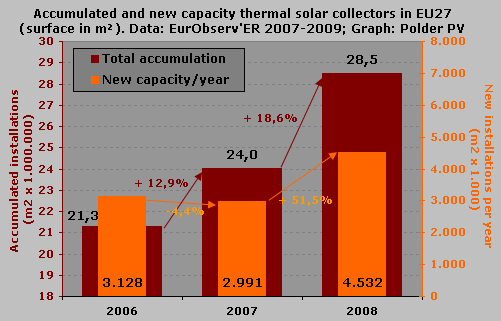
Figure
8. Thermal solar collector market development in EU27 in the years
2006-2008. Newly added surface (m²) per year stagnated from 2006
to 2007 (slight decrease in new capacity added), but grew again strongly
with almost 52% (added: over 4.500 m²) in the "crisis" year 2008
(orange columns, right Y-axis). Total accumulation of all m² installed
in
EU27 grew
strongly,
12,9% from 2006 to 2007, and even 18,6% from 2007 to 2008 (dark brown
columns in the background, left Y-axis). Already, a surface of 28,5
million square metres had been realized at the end of 2008 in the
27 EU countries.
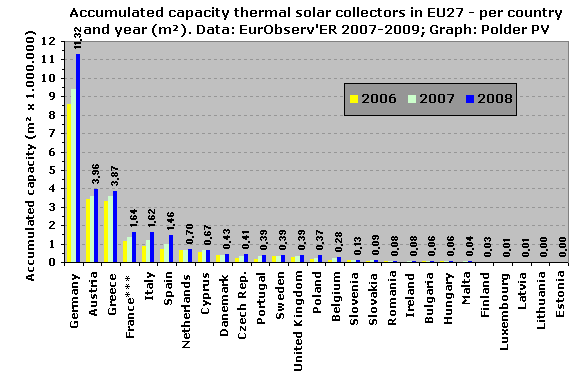
Figure
9. Surface area (in million square meters) of thermal
solar collectors in 27 EU countries. Again, Germany leads the way
in unprecedented
manner
(almost
3 times
as much surface area as the number 2), followed bij their southern,
also German-speaking neighbour Austria that has
a
long tradition with this sustainable energy modus. Thermal collectors
can be found on many roofs in the Mediterranean region, which is
reflected in the data from EurObserv'ER: Greece leading the way,
followed by France, Italy, and Spain. Surprisingly, Netherlands follows
on number 7, but development of the market again remains relatively
slow, despite a new temporary incentive regime. Only for 2008 the
accumulated
data
are
given per country.Growth in Germany has been considerable in 2008
(added: 1,92 million m²...).
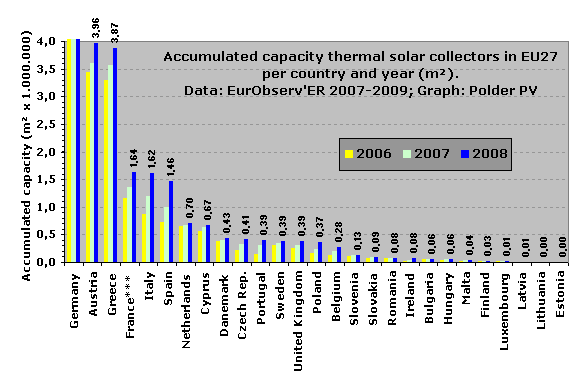
Figure
10. More detailed graph as figure 9, better outlining the contributions
of the "lesser" countries (Germany off-scale). Note that, apart from
progressive development in the numbers 2 (Austria) and 3 (Greece)
in 2008, also strong growth occurred in France, Italy and Spain.
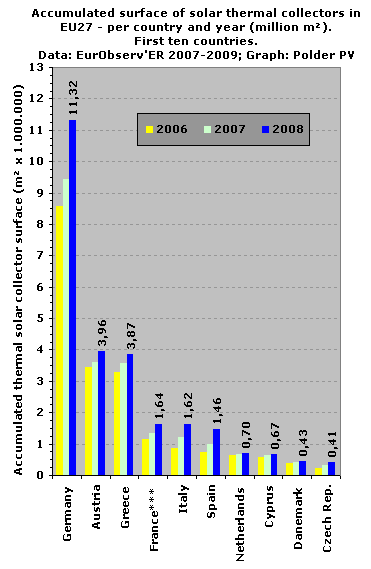
Figure
11. Detail showing the first 10 countries in the EU27, with a
considerable range of implemented thermal solar collector surface
areas. The difference between Germany and
the Czech Republik (number 10) has grown to a factor 28
in 2008 - the "span" between the numbers 1 and 10 is less wide than
with photovoltaics. The difference with the number 2, Austria, remains,
however
considerable - a factor of almost 2,9 in 2008.
Growth of Austria, Greece, and France was moderate. Italy and in
particular Spain (+35,2%) grew considerable. The latter 4 "top ten
countries" hardly grew, apart from the Czech Republic (+27,8%).
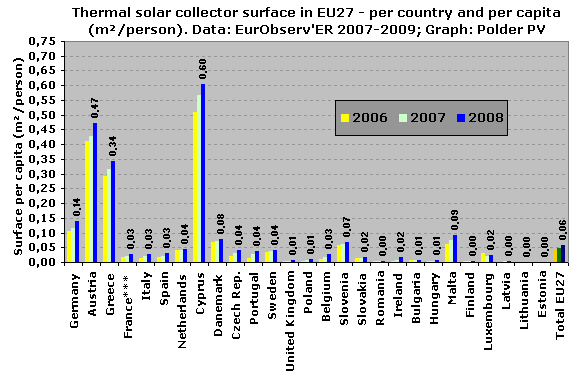
Figure
12. Accumulation of thermal solar collector capacity in EU27 countries
per inhabitant/capita and per year. Also for this graph, the World
Population Reference
Bureau data
for 2009 have been used in the calculations (hence: mid 2009 population
as fixed reference). And also in this picture, some other accents
become visible as in the original graphs with "absolute" surface
areas per country. This time, the small, sunny Mediterranean island
of Cyprus leads the way, with
a surface
of 0,6
m² per inhabitant.
Germany, leader when it comes to overall surface area realized, is
set back to the fourth place because of its large population (hence:
smaller
ratio
per inhabitant).
Austria
is
on the
second
position, followed by the only other serious competitor Greece.
Following Germany other countries have less than 0,1 square metre
per inhabitant, starting with that other Mediterranean island, Malta. At
the right end of the graph, the average data for
EU27 countries have been given in deviating colours. 0,06 m² per
capita has been realized in the EU27 in 2008, which easily should
and could get much larger. Thermal solar energy can offset a lot
of fossil primary energy use and should be stimulated with great
urgency.
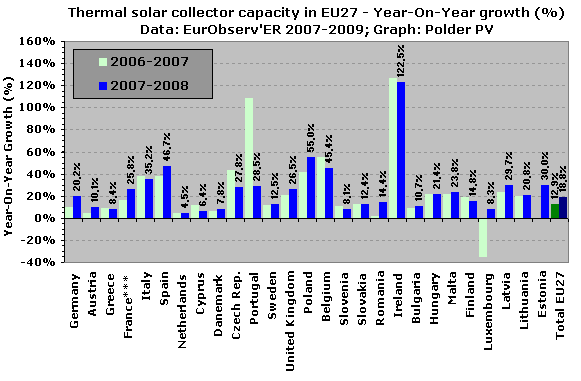
Figure
13. Year-on-year growth of the thermal solar collector markets in
EU27 countries for 2007 and 2008, in percentage of the previous market
accumulation
year published by EurObserv'ER. Actual percentages only presented
for the period 2007-2008 for all countries.
Yet
another picture emerging, with relatively "low" growth
in world market Germany (20% in the period 2007-2008), and suprising
strong growth for the Atlantic island nation of Ireland (123% in
2008). Other growth percentages are good and widely spread among
EU27 nations. Portugal had a short boom year in 2007 and fell back
to a more moderate 29% growth in 2008. Poor "growth performers" are,
yet again, my own country, the Netherlands, Cyprus and Denmark.
Even the large Greek market did not show strong appetite, with only
8,4% increase of the 2007 capacity into 2008. The minute state of
Luxembourg (part of the Benelux to which Netherlands and
Belgium
also belong)
had
a peculiar
negative
correction
(?) of
its installed capacity growth in the period 2006-2007, but started
growing again into 2008. Average European (EU27) growth numbers for
these two years were 12,9 and 18,8%, respectively.
Concentrating
Solar Power
In
het EurOberv'ER rapport ook een interessant overzichtje van de stand
van zaken rond de grootschalige productie van zonnestroom middels
grote CSP centrales. Voor details van de stand van zaken gelieve verder
te lezen op de website van
GEZEN, die alle ins en outs van deze typische
"industriële tak" van opwekking van hernieuwbare zonne-energie behandelt.
Anno 2008-2009 waren
in Spanje actief:
- PS10 tower project,
11 MW, project opgestart in 2006
- Aznalcollar TH
parabolische spiegelcentrale, 80 kW, opgestart in 2007
- PS20
vervolgproject met toren, 20 MW, opgestart in 2008
- Andasol
I, parabolische spiegelcentrale, 50 MW, in 2008
- Andasol
II, idem, 50 MW, in 2009
Gepland
voor 2009 en later:
- PE1/Puerto
Errdo, lineaire Fresnel reflector, 1,4 MW, in 2009
- 25 andere
projecten, het merendeel de klassieke parabolische spiegelcentrales,
met een totaal vermogen van 2.123 MW, vanaf 2010
Andere landen
doen ook wel iets, maar liggen ver achter op Spanje (binnen Europa).
- Eurodish research
project, parabolische spiegels, 10 kW, al in 2004 opgestart (Frankrijk)
- 3 andere projecten
in Frankrijk, 3 technologieën, 13,45 MW totaal, vanaf 2010
- Research tower
project in Jülich, Duitsland, 1,5 MW, vanaf 2008
- 2 projecten in
Italië, een parabolische spiegelcentrale van 5 MW, en een compacte
lineaire Fresnel reflector centrale van 6,5 MW, beiden vanaf 2010.
Volgens EurObserv'ER
zou er eind 2008 81 MW commercieel on-line zijn, en 232,4 MW eind 2009.
De vooruitzichten zijn veelbelovend, zeker met het gigantische en
met veel bombarie aangekondigde 100 GW Desertec project in Noord Afrika,
wat voor veel politieke "clout" zorgt ter ondersteuning van de grootschalig
toe te passen technologie. In Spanje en Italië zijn specifieke feed-in
tarieven voor CSP stroom in
het leven
geroepen
(26,9
resp.
22-28 eurocent/kWh). Volgens EurObserv'ER waren er eind 2008 wereldwijd
al 679 MW aan CSP centrales in bedrijf.
Progressie
hernieuwbare elektriciteit per land
In
deze grafiek uit het rapport (p. 93) wordt de situatie per land weergegeven
met het percentage hernieuwbare elektriciteit in de stroomconsumptie
voor 2008, de (Kyoto) doelstelling voor 2010. Nederland bezette in
2008 al een onbetekenende 15e plaats met 7,8% "hernieuwbaar".
Waarbij beslist aangetekend moet worden dat daar (deels ook praktijk
in andere
landen) een groot aandeel van twijfelachtige oorsprong bijzit (biomassa
bijstook in fossiele
energiecentrales
van
grote energieholdings, afvalverbranding met geschatte biogene fractie,
grootschalige verbranding van kippenmest uit de bioindustrie, etc.).
Dus zelfs al zou de beruchte "9% in 2010" met hakken over
de sloot worden gehaald: we mogen daar nooit "trots" op zijn,
omdat het fors bij elkaar gesjoemelde "nep-groene" elektriciteit
zal blijken te gaan (die ook nog eens nooit kleinschalig geproduceerd
zal kunnen worden).
Oostenrijk en Zweden
nemen de leiding: ze hebben al vele jaren het "geluk" dat ze grote
waterbekkens bezitten/gebouwd hebben, waar een zeer aanzienlijk deel
van hun stroommix mee kan worden opgewekt. Ook dit soort projecten
kunnen feitelijk alleen door grote, kapitaalkrachtige energieholdings
worden uitgevoerd, en zijn beslist geen teken van een "gezonde decentrale
energiemarkt".
Let op dat Duitsland
en, surprise, Hongarije, als enige EU27 landen reeds
(fors) over hun Kyoto doelstellingen zijn geraakt (bovenste zwarte
balkje).
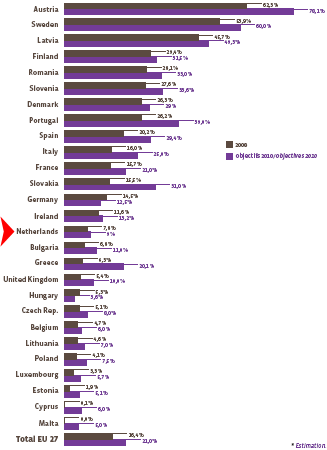
^^^
Figure 14. Share
of renewable electricity in gross consumption in EU27. 2008 (upper
bar) and 2010 objective (lower bar).
Nederland (rode
pijlkop) zakt steeds verder weg en is nog op zijn hoogst te kwalificeren
als een middenklasser binnen de EU27: in 2008 nog maar 7,8% "hernieuwbare"
elektriciteit (voor een aanzienlijk
deel van dubieuze "kwaliteit"),
doelstelling voor 2010 is 9%. Alleen een wonder kan ons land nog "redden"
en dat tussendoel
op zijn hoogst met de hakken over de sloot "haalbaar" maken. Misschien
nog wat extra gezonde geiten of een paar miljoen bioindustrie kippen
afmaken om
daar groene stroom van te maken?
Progressie
hernieuwbare (primaire) energie per land
In deze grafiek uit
het rapport (p. 90) wordt de situatie per land weergegeven met het
percentage hernieuwbare primaire energie als aandeel
van de totale consumptie voor 2008 (%).
Zweden, traditioneel
al over enorm potentieel aan waterkracht en over uitgestrekte bossen
beschikkend, neemt de leiding, verrassend gevolgd door het kleine oost-Europese
land Litouwen en het zich ook rijk aan grootschalige waterkracht rekenende
Oostenrijk. Let wel: dat zijn ook niet zwaar geïndustrialiseerde landen
met niet al te grote bevolkingspopulaties, en dat zijn factoren die
in dit soort grafieken natuurlijk extreem zwaar meewegen.
Vandaar dat het alom
bewonderde en geloofde Duitsland hier nog niet erg hoog in voorkomt,
pas op de 12e plaats vlak achter Italië wat natuurlijk ook al over
een fors hydropower potentieel in de Alpen kan beschikken, wat Duitsland
moet ontberen. Nederland doet het op dit vlak gruwelijk slecht, wat
natuurlijk wordt verergerd door een hoge bevolkingsdichtheid en
gigantische, fossiele energie zuipende industriële sectoren zoals de
enorme havenlokaties in de Europoort, andere energiezuipers als de
Botlek, Moerdijk, DSM terreinen, en niet te vergeten: de gas verslindende
glas- en tuinbouw industrie. Maar ook de ronduit dramatisch slecht
ondersteunde "opbouw" van een hernieuwbare energiesector, en continue
sabotage door veel te machtige partijen in ons land, maakt dat we ons
met een schandalige 22e plaats "tevreden" moeten stellen, achter diverse
oostblok landen, en net voor die andere achterlopers, Luxemburg (kan
niet heel erg veel op hun kleine stukje grond), België (is aan een
enorme inhaalrace bezig en heeft ons land op het vlak van zonnestroom
al ver achter zich gelaten), super smeerpoets U.K. (die met peperdure
quota systemen de eigen duurzame energiesector kort heeft gehouden,
en ook nog eens zwaar lijkt te willen inzetten op de achterhaalde nukes),
en dan nog twee kleine eilandstaatjes in de Mediterranée...
Het "gemiddelde"
voor EU27 bedraagt nog slechts 8,2 procent. Daar moet nog gigantisch
veel aan gebeuren, dat is wel duidelijk.
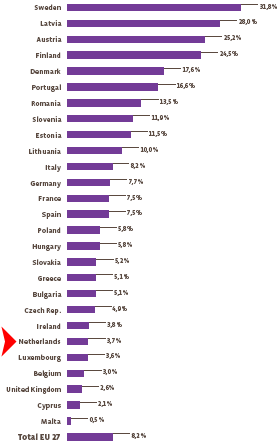
Figure
15. Share of renewable energy
in the primary energy consumption in EU27 in 2008
Totale impact van "hernieuwbaar"
(breed geïnterpreteerd) op de primaire energie
consumptie
in EU27.
Nederland
is een onbetekende
factor geworden door jarenlange politieke sabotage, desinteresse
en oe-ver-loos geouwehoer.
Links
http://www.eurobserv-er.org/ (homepage
pagina van waar het rapport kan worden gedownload)
http://www.eurobserv-er.org/pdf/barobilan9.pdf (het
rapport "The State of Renewable Energies in Europe/9th EurObserv'ER Report,
171 pagina's, 6,61 MB)
Pagina gepubliceerd
op 18 februari 2010
|
